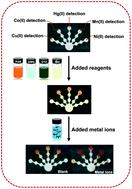Our official English website, www.x-mol.net, welcomes your
feedback! (Note: you will need to create a separate account there.)
Highly selective simultaneous determination of Cu(II), Co(II), Ni(II), Hg(II), and Mn(II) in water samples using microfluidic paper-based analytical devices
Analyst ( IF 3.6 ) Pub Date : 2021-1-26 , DOI: 10.1039/d0an02200d Pornphimon Kamnoet 1 , Wanlapa Aeungmaitrepirom , Ruth F Menger , Charles S Henry
Analyst ( IF 3.6 ) Pub Date : 2021-1-26 , DOI: 10.1039/d0an02200d Pornphimon Kamnoet 1 , Wanlapa Aeungmaitrepirom , Ruth F Menger , Charles S Henry
Affiliation

|
A new paper-based analytical device design was fabricated by a wax printing method for simultaneous determination of Cu(II), Co(II), Ni(II), Hg(II), and Mn(II). Colorimetry was used to quantify these heavy metal ions using bathocuproine (Bc), dimethylglyoxime (DMG), dithizone (DTZ), and 4-(2-pyridylazo) resorcinol (PAR) as complexing agents. The affinity of complexing agents to heavy metal ions is dependent on the formation constant (Kf). To enhance the selectivity for heavy metal ion determination, the new device was designed with two pretreatment zones, where masking agents remove the interfering ions. It was found that two pretreatment zones worked better than a single pretreatment zone at removing interferences. The reaction time, sample and complexing agent volumes, and complexing agent concentrations were optimized. The analytical results were achieved with the lowest detectable concentrations of 0.32, 0.59, 5.87, 0.20, and 0.11 mg L−1 for Cu(II), Co(II), Ni(II), Hg(II), and Mn(II), respectively. The linear ranges were found to be 0.32–63.55 mg L−1 (Cu(II)), 0.59–4.71 mg L−1 (Co(II)), 5.87–352.16 mg L−1 (Ni(II)), 0.20–12.04 mg L−1 (Hg(II)), and 0.11–0.55 mg L−1 (Mn(II)). The lowest detectable concentration and linearity for the five metal ions allow the application of this device for the determination of heavy metal ions in various water samples. The sensor showed high selectivity and efficiency for simultaneous determination of Cu(II), Co(II), Ni(II), Hg(II), and Mn(II) in drinking, tap, and pond water samples on a single device and detection with the naked eye. The results illustrated that the proposed sensor showed good accuracy and precision agreement with the standard ICP-OES method.
中文翻译:

使用微流体纸基分析装置高选择性同时测定水样中的 Cu(II)、Co(II)、Ni(II)、Hg(II) 和 Mn(II)
采用蜡印法制造了一种新的纸基分析装置,用于同时测定 Cu( II )、Co( II )、Ni( II )、Hg( II ) 和 Mn( II ) 。使用浴铜灵 (Bc)、二甲基乙二肟 (DMG)、双硫腙 (DTZ) 和 4-(2-吡啶基) 间苯二酚 (PAR) 作为络合剂,通过比色法定量这些重金属离子。络合剂对重金属离子的亲和力取决于形成常数 ( K f )。为了提高重金属离子测定的选择性,新装置设计有两个预处理区,其中掩蔽剂去除干扰离子。结果发现,两个预处理区在消除干扰方面比单个预处理区效果更好。对反应时间、样品和络合剂体积以及络合剂浓度进行了优化。 Cu( II )、Co( II )、Ni( II )、Hg( II ) 和 Mn( II ) 的最低检测浓度分别为 0.32、0.59、5.87、0.20 和 0.11 mg L −1 。 ), 分别。线性范围为 0.32–63.55 mg L -1 (Cu( II ))、0.59–4.71 mg L -1 (Co( II ))、5.87–352.16 mg L -1 (Ni( II ))、0.20 –12.04 mg L −1 (Hg( II )) 和 0.11–0。55 mg L -1 (Mn( II ))。五种金属离子的最低可检测浓度和线性度允许该装置用于测定各种水样中的重金属离子。该传感器在单一设备上同时测定饮用水、自来水和池塘水样中的 Cu( II )、Co( II )、Ni( II )、Hg( II ) 和 Mn( II ) 表现出高选择性和效率,用肉眼检测。结果表明,所提出的传感器表现出良好的准确度,并且与标准 ICP-OES 方法的精度一致。
更新日期:2021-02-17
中文翻译:

使用微流体纸基分析装置高选择性同时测定水样中的 Cu(II)、Co(II)、Ni(II)、Hg(II) 和 Mn(II)
采用蜡印法制造了一种新的纸基分析装置,用于同时测定 Cu( II )、Co( II )、Ni( II )、Hg( II ) 和 Mn( II ) 。使用浴铜灵 (Bc)、二甲基乙二肟 (DMG)、双硫腙 (DTZ) 和 4-(2-吡啶基) 间苯二酚 (PAR) 作为络合剂,通过比色法定量这些重金属离子。络合剂对重金属离子的亲和力取决于形成常数 ( K f )。为了提高重金属离子测定的选择性,新装置设计有两个预处理区,其中掩蔽剂去除干扰离子。结果发现,两个预处理区在消除干扰方面比单个预处理区效果更好。对反应时间、样品和络合剂体积以及络合剂浓度进行了优化。 Cu( II )、Co( II )、Ni( II )、Hg( II ) 和 Mn( II ) 的最低检测浓度分别为 0.32、0.59、5.87、0.20 和 0.11 mg L −1 。 ), 分别。线性范围为 0.32–63.55 mg L -1 (Cu( II ))、0.59–4.71 mg L -1 (Co( II ))、5.87–352.16 mg L -1 (Ni( II ))、0.20 –12.04 mg L −1 (Hg( II )) 和 0.11–0。55 mg L -1 (Mn( II ))。五种金属离子的最低可检测浓度和线性度允许该装置用于测定各种水样中的重金属离子。该传感器在单一设备上同时测定饮用水、自来水和池塘水样中的 Cu( II )、Co( II )、Ni( II )、Hg( II ) 和 Mn( II ) 表现出高选择性和效率,用肉眼检测。结果表明,所提出的传感器表现出良好的准确度,并且与标准 ICP-OES 方法的精度一致。











































 京公网安备 11010802027423号
京公网安备 11010802027423号